ANYsec
Nokia ANYsec uses the IEEE802.1AE (MACsec) encryption engine in the Nokia FP5 chipset to encrypt MPLS payloads, while leaving the MPLS labels in clear and unauthenticated. After the MPLS payload is encrypted, the MPLS packet is switched through an MPLS network and eventually is decrypted using the encryption engine at the terminating FP5-enabled PE. Having the MPLS labels in clear and unauthenticated allows any LSR router to switch the ANYsec packets from the ILER ANYsec PE to the ELER ANYsec PE. Any LSR router, including third-party routers, can manipulate the MPLS header. This includes performing label actions such as label swap, pop, and push.
The following figure shows the ANYsec MPLS encryption and decryption process.
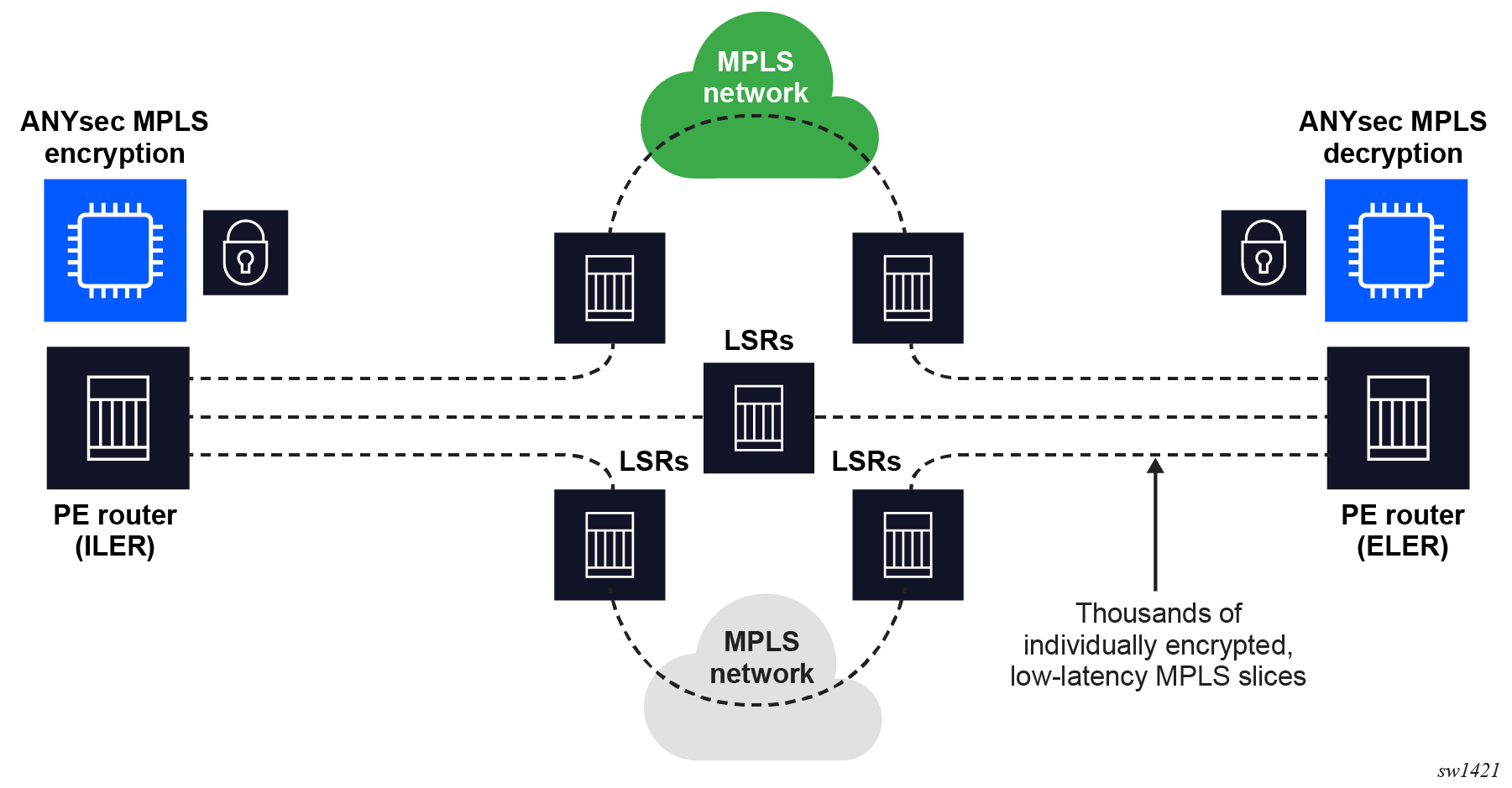
ANYsec overview
Nokia ANYsec uses IEEE802.1AE (MACsec) as its datapath encryption engine and IEEE802.1x (dot1x/MKA) as its control plane signaling protocol. ANYsec uses the user-configured MACsec connectivity-association (CA) with a set of pre-shared keys (PSKs), the same way MACsec does, to negotiate datapath keys between two or more peers.
The following is the basic high-level overview of the SR OS ANYsec encryption process.
- The user configures the ANYsec-specific CA, which supports the exclusive use of the
CA with ANYsec
encryption.
configure macsec connectivity-association anysec true - The MACsec key agreement (MKA) key server generates the datapath security
association keys (SAKs) locally on the SR OS.
The user configures the key-server selection priority using the following
command.
configure macsec connectivity-association static-cak mka-key-server-priority - The MKA uses CMAC-AES-128/256 to encrypt the SAKs using PSK and distributes the SAKs.
- ANYsec modifies the MKA for transport over IP/UDP (described in more detail in later topics). MKA distributes the SAKs between peers, and ANYsec uses the SAKs to encrypt the MPLS payload via the IEEE802.1AE encryption engine.
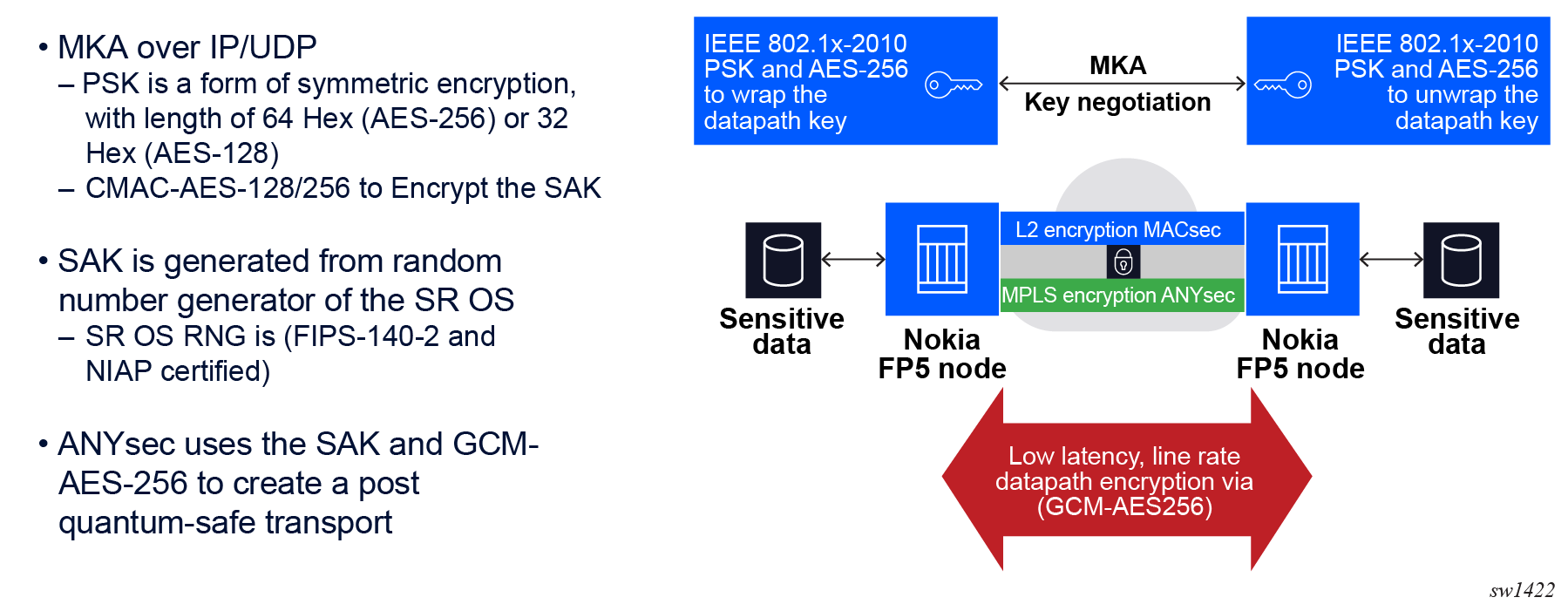
ANYsec packet format
ANYsec MPLS provides packet encryption formats that are different from the MACsec packet formats.

The following figure shows that the MACsec WAN mode leaves the dot1q VLANs in clear and unauthenticated, so the packets can be manipulated by the VLAN switched network.

With ANYsec, the entire MPLS label stack is in clear and unauthenticated. This allows the LSR routers to manipulate the MPLS label stack while the system encrypts and authenticates the payload. The following figure shows ANYsec MPLS packet authentication.

ANYsec encryption
Nokia FP5 ANYsec uses the IEEE802.1AE (MACsec) encryption engine to encrypt multiple layers of OSI. For example, the same encryption engine can encrypt at Layer 2, MACsec, or Layer 2.5 MPLS ANYsec.
ANYsec encryption supports MACsec encryption algorithms, MPLS protocols, and per-flow encryption.
Encryption algorithms
ANYsec uses the MACsec encryption engine and therefore supports all the MACsec encryption algorithms, including the following:
- CMAC-AES-128/AES-256 for pre-shared key encryption used by the MKA protocol
- GCM-AES 128/256 for datapath encryption, using extended packet number (XPN)
MPLS protocol support
ANYsec currently encrypts LSPs that are signaled by the following Segment Routing (SR) protocols:
- SR-ISIS
- SR-OSPF
- SR-OSPF3
Currently ANYsec encrypts the service label, entropy label, and entropy-indication label.
per-flow encryption
configure macsec connectivity-association static-cak mka-key-server-priorityANYsec uses the Layer 3 content addressable memory (CAM) build in the Nokia FP5 chipset to match the MPLS label stack to the appropriate SAK. When a SAK for an LSP is distributed via MKA, ANYsec downloads the LSP's label stack to the Layer 3 CAM and associates it with the corresponding SAK, which it downloads to the SA lookup table.

ANYsec and MACsec interaction
If ANYsec is enabled on the network ports, SR OS only supports enabling MACsec on the access ports. If MACsec and ANYsec are on the same IOM and FP5 chipset, MACsec uses scaling resources from ANYsec. For example, if a single MACsec port is configured on the same IOM as ANYsec, the ANYsec scale drops by 1 on that IOM. This is because both MACsec and ANYsec use the same SA lookup table, which has a defined number of entries.
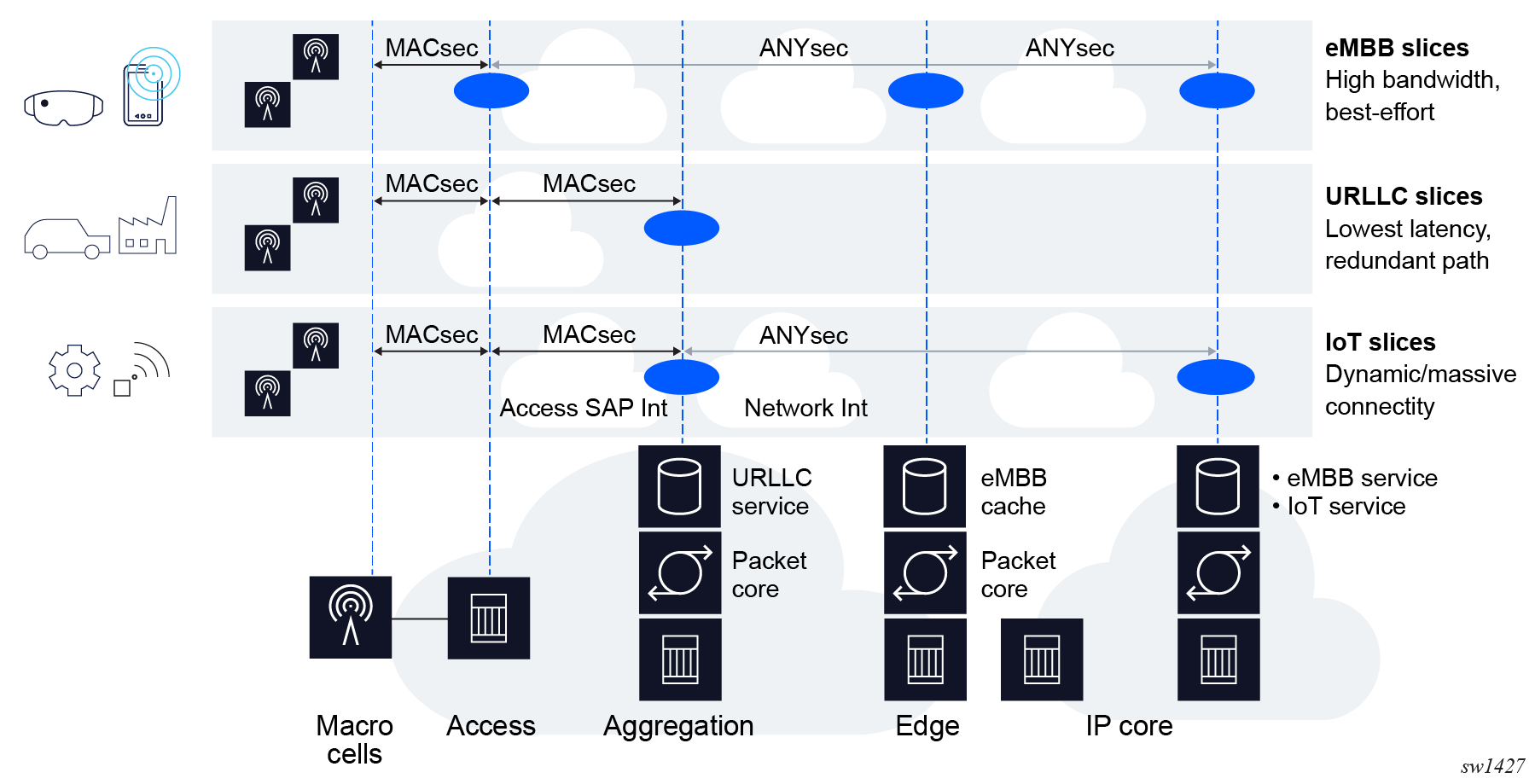
ANYsec and LAG and ECMP interaction
When LSPs are enabled with ANYsec on ILER, the LSPs do not hash their internal flows over multiple ECMP interfaces or over LAG members. Instead, each LSP on ILER maps to a dedicated ECMP interface or LAG member. If an ANYsec LSP is transporting multiple services or IP flows, all the services and IP flows map to a single interface in an ECMP group, or to a single member in a LAG bundle on the ILER. However, if there are multiple ANYsec LSPs on the ILER, each ANYsec LSP and all the flows within the LSP can also hash to a different interface in an ECMP group or a different LAG member in a LAG bundle.
The LSR routers can hash the ANYsec LSPs over an ECMP group interface or a LAG member freely without any restrictions.
Inter AS and Inter Area solutions
ANYsec LSPs support a single-area solution only. ANYsec does not support inter-AS or inter-AREA option B or option C (for example, seamless MPLS).
ANYsec supports inter-AS or inter-AREA option A with the following conditions:
- The termination of the ANYsec LSP is at the ABR or ASBR router.
- Another ANYsec LSP originates toward the other inter-AS or inter-AREA option A.
In addition, ANYsec does not support tunnels within tunnels. For example, an ANYsec LSP that is encrypted cannot be encapsulated in a second MPLS tunnel such as BGP LU, RSVP-TE, or LDP.
ANYsec implementation design
ANYsec supports the following implementation design:
- At the MKA signaling layer, ANYsec supports assigning the PSKs and the CAs to a group of Segment Routing (SR) tunnels. This assignment is known as Encryption Groups (EG) in ANYsec. EGs support easy management of PSKs for ANYsec tunnels, because multiple tunnels can use the same PSK.
- MKA is established per pair of peers, thereby allowing encryption of each tunnel with its own dedicated SAK. The use of a dedicated SAK per tunnel ensures a high level of security. For ease of management, ANYsec supports using PSKs per group of tunnels. However, for maximum security, the SAK is only supported per pair of peers.
- ANYsec supports tunnel slicing using Flex Algo or multi-instance IGP. Each slice is uniquely identified and a SAK is assigned per slice (per set of peers). ANYsec can also uniquely identify each LSP on each slice, and assign an EG to the LSPs through user configuration.
- ANYsec uses the MKA Layer 2 protocol for signaling, which uses IEEE 802.1x for encapsulation. To transport MKA over IP in a Layer 3 network, ANYsec encapsulates MKA over IP/UDP. The UDP port uniquely identifies the MKA packets to the ANYsec peers. The IP header transports the MKA packet from one ANYsec PE to another ANYsec PE.
The following figure shows the ANYsec design implementation and related requirements.
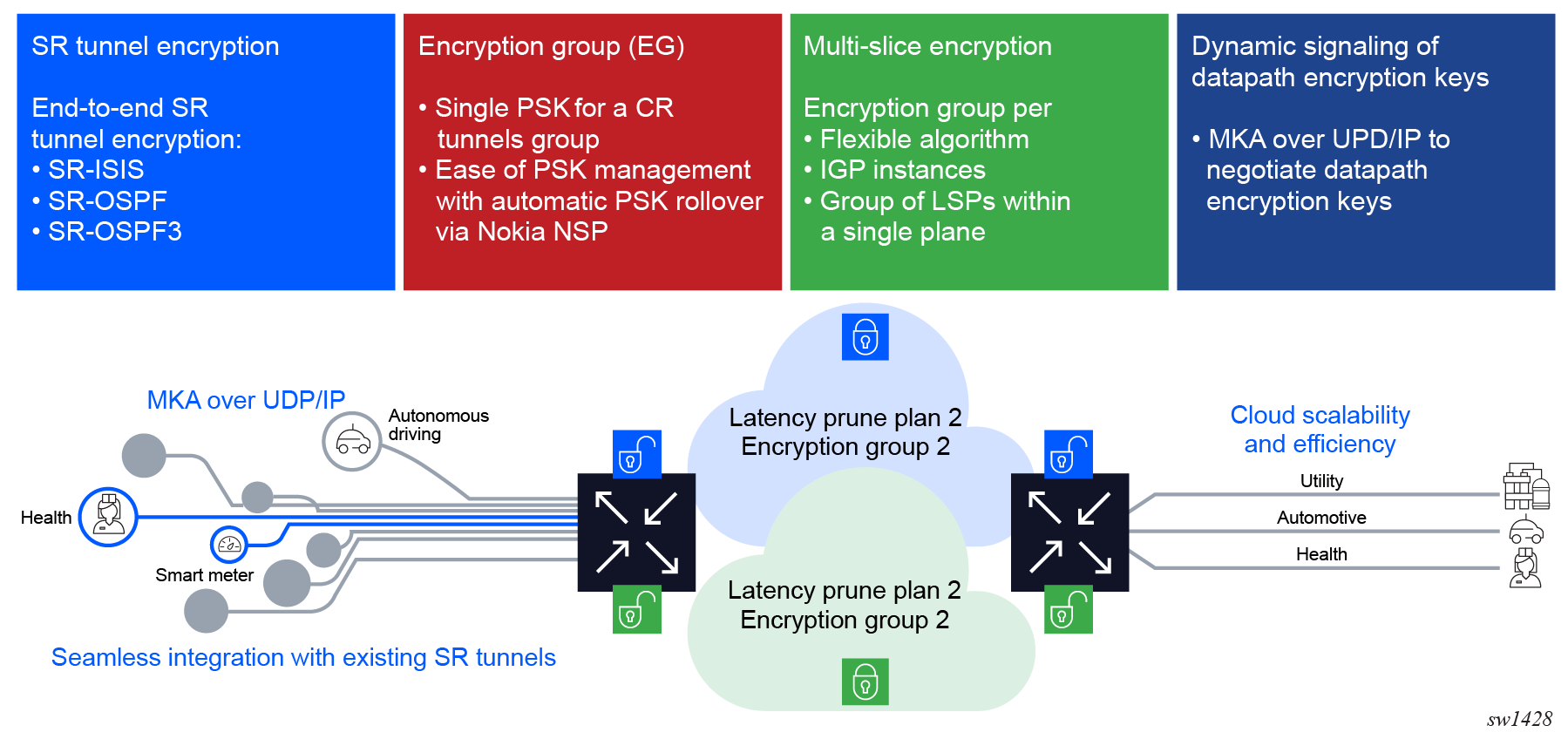
ANYsec configuration guidelines
These topics describe the basic configuration requirements to implement Nokia ANYsec MPLS encryption.
Configuring ANYsec connectivity association and PSK
ANYsec uses MKA for its control plane and for signaling of SAKs, and therefore ANYsec reuses the MACsec connectivity association (CA) and the PSKs. SR OS supports creation of the CA uniquely for ANYsec. When the anysec command is enabled under the CA, SR OS supports the exclusive use of the CA with ANYsec encyrption; this CA cannot be reused for MACsec any longer.
configure macsec connectivity-association anysecANYsec supports the static-cak and the cipher-suite commands for the CA configuration. When a CA is configured for ANYsec, it does not support the following CA configurations:
- clear-tag mode
- delay protection
- encryption offset
- MACsec encryption
- replay-window size
- MAC policy
ANYsec also does not support configuration of a MACsec MAC policy.
The following example displays an ANYsec CA configuration.
MD-CLI
[ex:/configure macsec]
A:admin@node-2# info
connectivity-association "CA-1" {
admin-state enable
cipher-suite gcm-aes-xpn-256
anysec true
static-cak {
mka-hello-interval 5
pre-shared-key 1 {
encryption-type aes-256-cmac
cak "2yzrsjg5sp7MYAnWpod+Nkn4SwXf7OPMEfAMRpNh9Gu/badNTWOoYEG9Qi1NDOBW hash2"
cak-name "11"
}
}
}classic CLI
A:node-2>config>macsec# info
----------------------------------------------
connectivity-association "CA-1" create.
anysec
cipher-suite gcm-aes-xpn-256
static-cak
pre-shared-key 1 encryption-type aes-256-cmac create
cak "2yzrsjg5sp7MYAnWpod+Nkn4SwXf7OPMEfAMRpNh9Gu/badNTWOoYEG9Qi1NDOBW" hash2
ckn "11"
exit
mka-hello-interval 5
exit
no shutdown
exitIdentifying and configuring ANYsec LSP
After configuring the CA as described in Configuring ANYsec connectivity association and PSK, the next step is to identify the LSP to encrypt. The benefit of ANYsec is the ability to easily enable encryption on an LSP at any time, without changing the LSP's service lease agreement (SLA). ANYsec achieves this by doing the following:
- ANYsec uses the MACsec engine to achieve low latency, line rate encryption, with less than 1us and with in 100s of ns of introduced encryption and decryption latency.
- ANYsec identifies an LSP to encrypt using a disjoint configuration, and encrypts it independently, allowing creation of MPLS networks with appropriate design and SLA that can be expanded to include encryption on LSPs in the future.
- ANYsec uses bidirectional configuration, even for LSPs that are unidirectional, and therefore the ANYsec configuration has to identify an outgoing LSP to encrypt and an incoming LSP to decrypt, under the same encryption group.
The following example displays a configuration to enable encryption on the egress LSP with the node SID 1.1.216.136, and decryption for the local node SID bound to 1.1.216.100. Both LSPs are on IGP instance ID 11.
MD-CLI
[ex:/configure anysec]
A:admin@node-2# info
reserved-label-block "rlb-1"
mka-over-ip {
mka-udp-port 12345
}
tunnel-encryption {
security-termination-policy "STP-1" {
admin-state enable
local-address 1.1.216.100
igp-instance-id 11
}
security-termination-policy "Sec-Term-Policy" {
}
security-termination-policy "test-policy" {
}
encryption-group "EG-1" {
security-termination-policy "STP-1"
ca-name "CA-1"
peer-tunnel-attributes {
igp-instance-id 11
}
peer 1.1.216.136 {
admin-state enable
}
}
}
classic CLI
A:node-2>config>anysec# info
----------------------------------------------
reserved-label-block "rlb-1"
mka-over-ip
mka-udp-port 12345
exit
tunnel-encryption
security-termination-policy "STP-1" create
igp-instance-id 11
local-address 1.1.216.100 //decrypt the incoming LSP for local node sid
no shutdown
exit
encryption-group "EG-1" create
ca-name "CA-1"
security-termination-policy "STP-1"
peer-tunnel-attributes
igp-instance-id 11
exit
peer 1.1.216.136 create //encrypt the outgoing LSP for remote node sid
no shutdown
exit
no shutdown
exit
exitThe security-termination policy identifies the decrypting LSP and the node SID on the local router. The decrypting LSPs node SID can arrive from multiple peers, and the SAKs used to decrypt these incoming LSPs are different for each peer.
The encryption group is a group of peers that use the same CA and PSK to secure the SAK over MKA. Each peer node SID and its local node SID use a different SAK to encrypt the datapath, but all these SAKs under the same encryption group are secured and signaled via the same CA and PSK.
A security-termination policy can be part of multiple encryption groups, however, a peer can only be part of a single encryption group. This allows a set of bidirectional LSPs in an encryption group to use the same CA and PSK to secure and signal SAKs between them.
The following figure shows the implementation of ANYsec tunnel encryption using two encryption groups with the same security termination policy, and different CAs and peers.
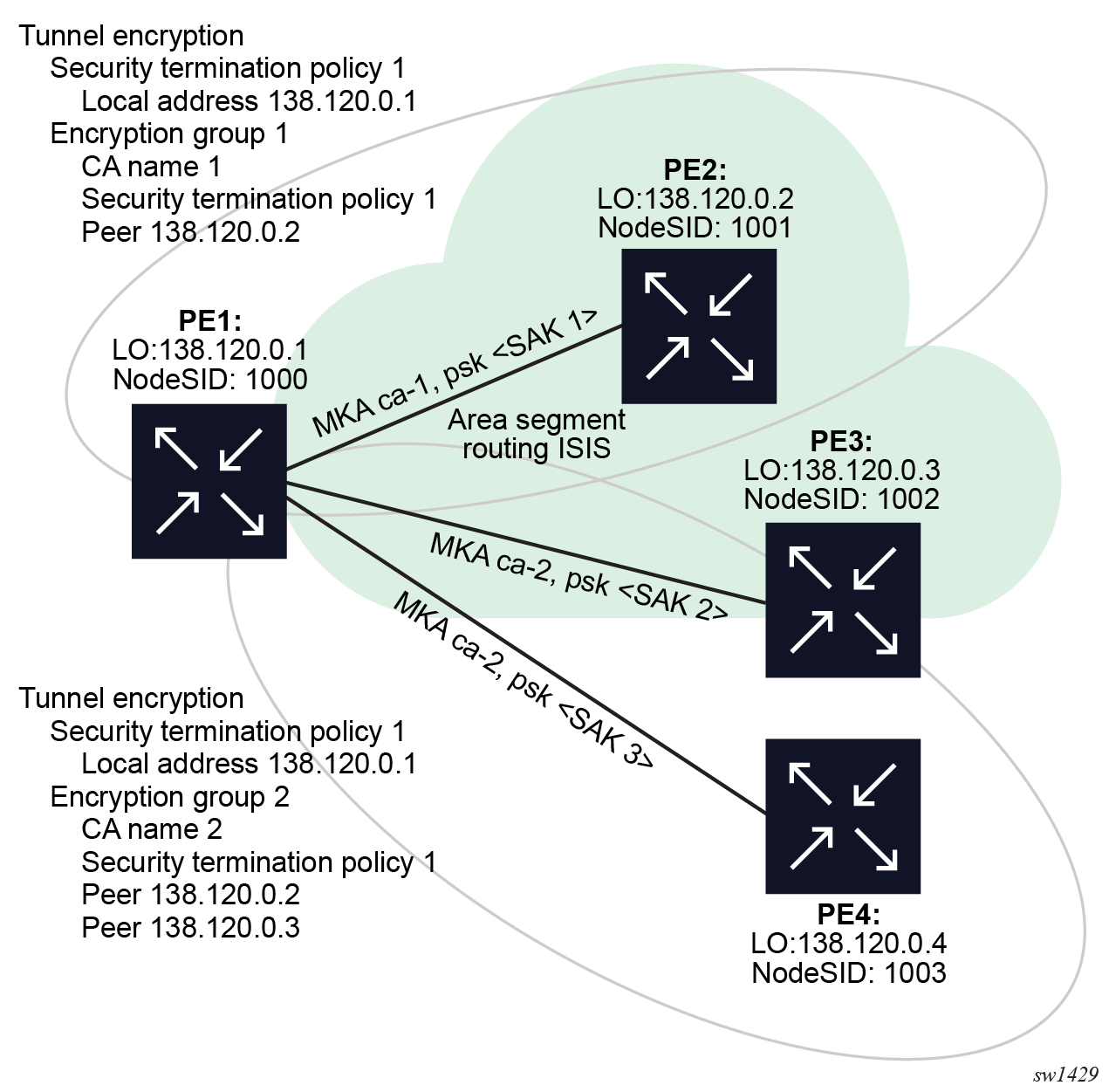
Configuring ANYsec MKA
ANYsec uses MKA to distribute SAKs. MKA is part of IEEE802.1x standard and is a Layer 2 protocol without an IP header. As an MPLS Layer 2.5 encryption protocol, ANYsec reuses MKA by encapsulating MKA in IP/UDP to distribute the SAK from one PE to the other.
The user-configurable UDP port identifies the MKA packets on the router. The following configuration guidelines apply:
- Reserve the UDP port for MKA for the entire network.
- Ensure that the UDP port is not in use by any other application.
Use the following command to configure the MKA UDP port.
configure anysec mka-over-ip mka-udp-portThe following figure shows the ANYsec implementation using the MKA UDP port configuration.

Configuring ANYsec encryption SIDs
With ANYsec, the encryption engine locks on a unique label stack and encrypts it with a unique SAK. This label stack needs to be programmed by SR OS in the encryption engine. This creates a problem with double encryption in segment routing technology. In segment routing, all peers wanting to send a packet to a local router, send the packet to the node SID of the local router. As such, the label stack that is pushed on the packet by different routers to switch the packet to the local router may be identical. This means if an encrypting node is also an LSR node for an upstream router, it would encrypt its own local packets to the downstream ANYsec router and would double encrypt the upstream ANYsec router packets that are going through it to the same downstream ANYsec router. For example, in the following figure PE2 would encrypt its own packet destined for PE3 and double encrypt the PE1 packets with same MPLS label stack destined for PE3. This double encryption would mean that PE1 packets are not decrypted correctly at PE3.
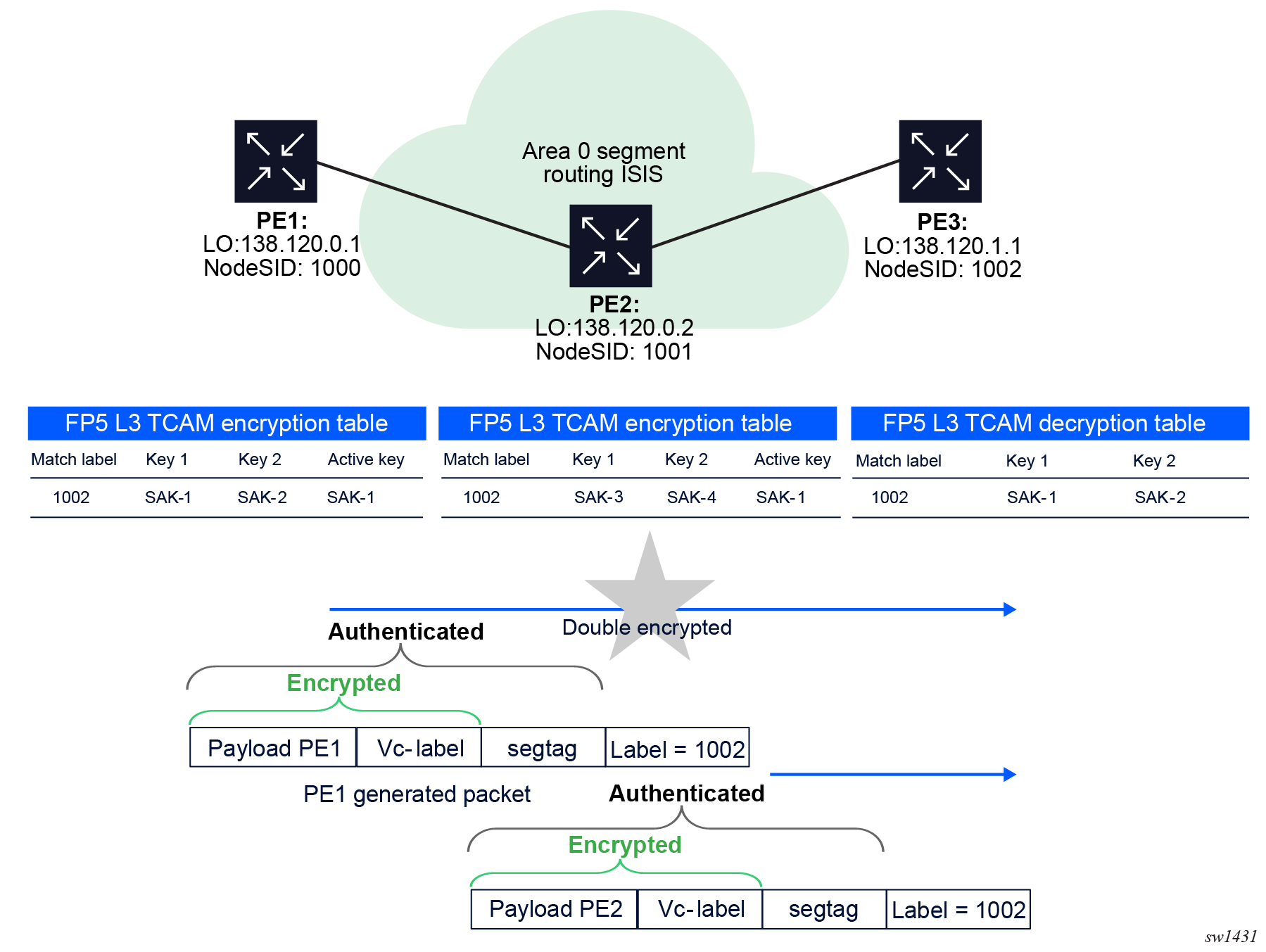
To solve this problem, SR OS introduced the encryption SID concept. The encryption SID uniquely identifies the encrypting router within the network. The encryption SID is pushed by the encrypting router at the bottom of the label stack with S bit set.
In the following figure, the encryption SID 2000 is assigned to PE1 encrypting node and encryption SID 2001 is assigned to PE2 encrypting node. Both sending packets to PE3.
The encryption SID pushed at the bottom of the label stack ensures that each encrypting node has a unique label stack so double encryption does not occur on the PE2. The PE2 ANYsec CAM is only programmed to encrypt the label stack of <2001(S=1),1002> and does not match the label stack of <2000(S=1),1002> from PE1.
Ensure the following conditions are met for the encryption SID used in the ANYsec configuration:
- The encryption SID for the ANYsec configuration must be uniquely assigned to each encrypting router.
- The encryption SID for the ANYsec configuration must be assigned from a reserved block of labels on SR OS.

The following example displays a configuration of an encryption SID on a encrypting node.
MD-CLI
[ex:/configure router "Base" mpls-labels]
A:admin@node-2# info
sr-labels {
start 60000
end 120000
}
reserved-label-block "r1b-1" {
start-label 50000
end-label 59999
}
[ex:/configure anysec]
A:admin@node-2# info
reserved-label-block "r1b-1"
mka-over-ip {
mka-udp-port 12345
}
tunnel-encryption {
security-termination-policy "STP-1" {
admin-state enable
local-address 1.1.216.100
igp-instance-id 11
}
security-termination-policy "Sec-Term-Policy" {
}
security-termination-policy "test-policy" {
}
encryption-group "EG-1" {
admin-state enable
security-termination-policy "STP-1"
encryption-label 50012
ca-name "CA-1"
peer-tunnel-attributes {
igp-instance-id 11
}
peer 1.1.216.136 {
admin-state enable
}
}
}
classic CLI
A:node-2>config>router>mpls-labels# info
----------------------------------------------
sr-labels start 60000 end 120000
reserved-label-block "rlb-1" //reserved block for encryption sid
start-label 50000 end-label 59999
exit
----------------------------------------------
A:node-2>config>anysec# info
----------------------------------------------
reserved-label-block "rlb-1" //reserve blocked assigned to ANYsec
mka-over-ip
mka-udp-port 12345
exit
tunnel-encryption
security-termination-policy "STP-1" create
igp-instance-id 11
local-address 1.1.216.100
no shutdown
exit
encryption-group "EG-1" create
ca-name "CA-1"
encryption-label 50012 //encryption sid that uniquely identifies this encrypting node and is pushed on the bottom of label stack when the node encrypts the LSP.
security-termination-policy "STP-1"
peer-tunnel-attributes
igp-instance-id 11
exit
peer 1.1.216.136 create
no shutdown
exit
no shutdown
exit
exit
ANYsec OAM MPLS support
OAM support with Segment Routing tunnels
ANYsec supports OAM with following Segment Routing tunnels:
- SR-ISIS
- SR-OSPF
- SR-OSPF3
OAM command support
ANYsec supports OAM tools including P2MP LSP ping and services OAM tools if any services are riding over the ANYsec tunnel. ANYsec supports the use of the following inband OAM commands:
- LSP ping
- SDP ping
- VCCV ping
- Service ping
- ping over a non default service
- L2 service ping